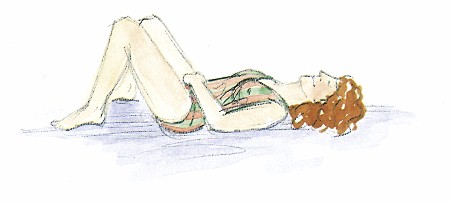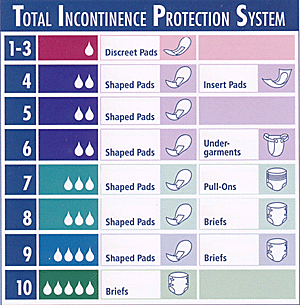Incontinence Help

More than 19 million people in North America experience incontinence or bladder leakage. Millions more care for a loved one with incontinence. Incontinence is not a disease; it is always a symptom or side effect of another medical condition. Many of the causes are temporary and can be managed with simple treatment.
A Doctor can help
Talk with your doctor about your condition. An examination can help find the cause and suggest the best ways to correct or manage the incontinence condition. Remember, the earlier you seek medical help for yourself or your loved one, the sooner changes can begin.
What is Incontinence?
Incontinence is the inability to control urination or bowel movements. Incontinence is a symptom, not an illness. It is a sign of something else happening in the body, not a sign of aging.
Urinary incontinence or bladder leakage involves the urinary system, the pelvic muscles, the spinal cord, and even transmissions of messages to and from the brain. When one of these fails, bladder leakage occurs and urine is released at the wrong time.
What causes Incontinence?
Incontinence can have a number of causes. The most common are:
- Relaxation of the Pelvic muscles, often seen in women over 35 who have had several children
- Reduced muscle control that can occur with menopause.
- Infections or inflammation of the bladder or the urethra, the tube that leads from the bladder to outside of the body.
- Nervous system disorders, resulting from birth defects (such as spina bifida), brain damage or stroke, diabetes, or spinal cord injuries.
- Neuromuscular diseases, such as Multiple Sclerosis, Muscular Dystrophy, and Cerebral Palsy.
Certain medication, caffeine, and alcohol can make incontinence worse.
Is all Incontinence the same?
No. It varies from person to person and from day to day. Generally, there are three levels of incontinence.
- Light incontinence is occasional, uncontrolled voiding of a small amount of urine.
- Moderate incontinence is uncontrolled voiding of small to moderate amounts of urine.
- Severe incontinence is uncontrolled daily voiding of moderate to large amounts of urine and /or stool.
Of course incontinence affects each person differently. It’s all a matter of lifestyle and attitude.
Types of Bladder Weakness or Incontinence Below
Stress - Incontinence
With Stress Incontinence we mean involuntary urine-loss (mostly drops or small gushes) when laughing, sneezing, or coughing. During physical exertion like sporting, exercising, or lifting, the person can also experience involuntary urine-loss, without active contractions of the bladder-muscles. With “Stress” in this case, we mean the pressure in the pelvic-floor area.
Reasons for Stress - Incontinence
Under normal circumstances, when the pressure in the pelvic-floor area is increased (for example during the instances described above), the pressure inside the bladder is also increased. The result is that the pelvic-floor muscles and the rectal muscles contract as a reflex. The bladder and the urine-tubes are closed and there is no involuntary urine-loss. At the same time, the pelvic-floor muscles support the bladder and keep the bladder and the surrounding organs in their place. When the pelvic-floor muscles and the supporting tissue are weakened through repetitive pregnancies, childbirth, or hormonal changes, there is a risk for involuntary urine-loss. In that case, the necessary support of the pelvic-floor muscles is decreased or absent. The bladder with its muscles do not close anymore during laughing, sneezing or coughing and drops of urine might be lost during these instances.
Overflow - Incontinence
With Overflow Incontinence we mean involuntary urine-loss (mostly drops or small gushes) with irregular intervals and or at night without actually emptying the bladder.
Reasons for Overflow - Incontinence
The contraction of the bladder muscles has been weakened intensively. Another reason might be a narrowing of the urine-tubes as a result of a prostate - enlargement or a tumor that presses on the urine-tubes.
Urge - Incontinence
With Urge Incontinence the person experiences an urgent need to urinate and cannot get to the toilet in time. It might even happen if the bladder is emptied completely.
Reasons for Urge Incontinence
The bladder muscles are too active. The urine-level inside the bladder is increased without the bladder noticing any real increase in pressure. Usually, the bladder muscles do not contract in the “rest” periods between urinating.
Due to the large activity in the bladder muscle, the muscle gets activated with minimum amounts of urine, or through psychological or physical stimuli. These stimuli result in a contraction of the bladder muscles. The pressure inside the bladder increases; there is a need to urinate. The pressure rapidly becomes very large and there is involuntary urine-loss.
Such an overactive bladder muscle is usually the result of neurological diseases or infections.
Fecal- Incontinence
Fecal Incontinence is the disability to hold gas and bowel movements. It might also mean the loss of control over the contraction muscles at times of bowel movements.
Reasons for Fecal Incontinence
Some reasons for Fecal Incontinence are operations, damages of the nerves, weakness of the muscles, Colitis Ulserosa (a tarm-infection), the Croh-disease.
Total - Incontinence
The person has no control left over bladder and bowel. The toilet is not used anymore to urinate.
Reasons for Total Incontinence
Brain damage, dementia, damages in the spinal core, or other deficiencies in the bladder and/or the bowel.
Always consult your doctor!
No matter how comfortable we try to make our Attends products, there is nothing more important than a good functioning body. We therefore recommend you to always consult a doctor or another specialist about the causes of your complaints. In many cases, you need a prescription from your doctor to get the incontinence care you need.
In some cases of light bladder weakness, like stress incontinence, there is a lot of progress to be made with pelvic floor exercises. To reach the maximum effect, you would need to exercise a few minutes every day.
Daily exercises to strengthen the pelvic floor muscles.
It is important that you find the right muscles for training to get the desired result. We know that approximately 30% of all women find this very difficult. When in doubt about doing the exercises correctly, you should consult your doctor or physical therapist for help.
These exercises can prevent, decrease and/or even cure urine loss. However, this is under the condition you exercise 2 to 4 times daily.
How do I locate the pelvic floor muscles?
The pelvic floor muscles connect several organs in the lower part of the body. Organs like the bladder “rest” on the pelvic floor muscles. To ensure the vitality and the right placement of these organs it is important the pelvic floor muscles are in good shape.
Below you can see two exercise forms that help you train the pelvic floor muscles:


How do I tighten my pelvic floor muscles?
It is impossible for you to “see” the pelvic floor muscles. But with this exercise you will consciously learn to feel and tighten your pelvic floor muscles. Please lay down on your back with your knees lifted up, your legs lightly spread (see picture 1 or 2).
Try with squeezing your rectal muscles. Try to move this “squeeze and lift” feeling to your pelvic floor muscles. You will feel the muscle lifting up inside your body (as if you were trying to stop urinating). During this exercise, you should try to keep your buttocks, thighs and stomach relaxed. For the best effect, the squeezing and lifting of the pelvic floor muscles should happen when you breathe out. Try to squeeze and lift for 2 seconds, then relax for 2 seconds.
Strengthen your pelvic floor muscles
Take the starting position as described above. Try to squeeze and lift your pelvic floor muscles for 2-5 seconds. Take the same time to relax. Breathe in normally (relax) and breathe out (squeeze and lift). Repeat this exercise 5-10 times and try to exercise daily at least 4 times.
Tips
- Don’t forget to squeeze and lift your pelvic floor muscles when your carry heavy objects or bags!
- If you already experience light urine loss during your daily activities, try to do the exercise during these activities.
- For an optimal effect, you should do these exercises daily for a period of at least 3-6 months.

We hope you learned more about the loss of bladder control and what you can do to keep it from interfering with your daily activities. With appropriate management, you can carry on a healthy and active lifestyle without fear or embarrassment. Your health care professional can assist you in selecting the right absorbent product while you undergo treatment or when treatment is not completely successful.


